Marantz Cinema 40 Reviewed at $3,500.00
Product Name: Marantz Cinema 40
Product Description: 9.4 CH 8K AV Receiver
-
Design - 9.6/10
9.6/10
-
Audio Quality - 9.5/10
9.5/10
-
Inputs / Ports - 9.5/10
9.5/10
-
OS, Apps and Features - 9.5/10
9.5/10
-
Price / Quality - 8.6/10
8.6/10
Summary
Reviewed at $3,500.00
Pros
- Top sound quality
- 40Gbps HDMI 2.1 ports
- Extensive connectivity options
- Dirac Live ready
Cons
- Price is much higher than previous releases
- No front HDMI input
- Audyssey MultiEQ editing app is not free
- Questionable porthole design
Cheapest Places to Buy :
*We are a reader-supported website. When you buy through links on our site, we may earn a small affiliate commission at no extra cost to you. Home Media Entertainment does not accept money for reviews.*
We have already gone through three of the latest AV receivers from Marantz that were released towards the end of 2022 and the beginning of 2023. What we were missing was Marantz’s flagship that came to the market recently and surely is an AV receiver that means serious business. And here in Home Media Entertainment we couldn’t do without testing this mighty beast so in our Marantz Cinema 40 review today we will put Marantz’s top tier offering through its paces to see what it is made of.
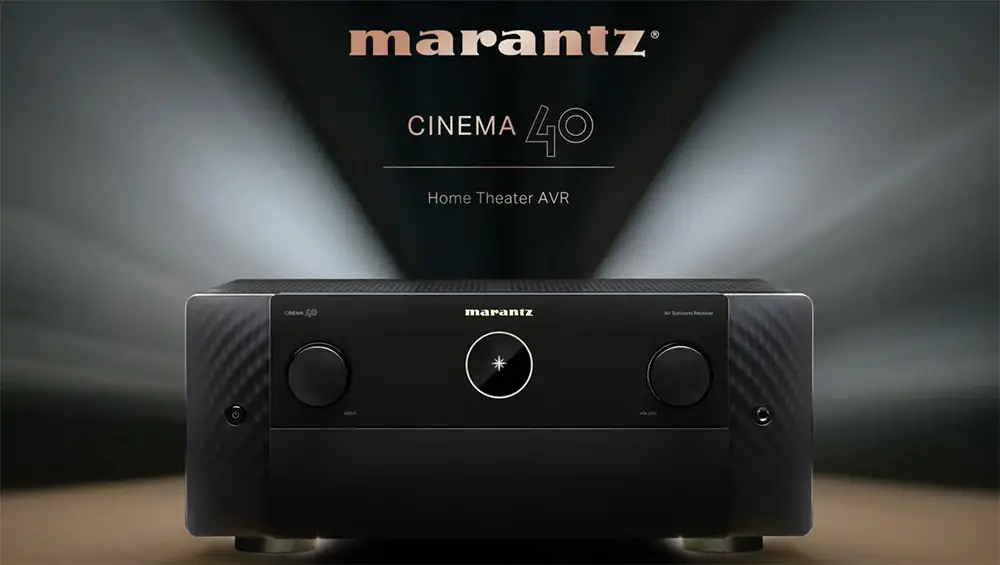
After testing out the Cinema 60, Cinema 50 and Marantz’s slimline Cinema 70s, checking out the Cinema 40 clearly shows that this bad boy is on a completely different level. The Cinema 40 is not meant to replace Marantz’s behemoth, the SR8015, but instead replaces the next in line, the SR7015 which shares similar characteristics to this one. So we are going to see what have changed compared to its predecessor and also what are the differences compared to the awfully similar Denon AVR-X4800H.
But before we start our thorough analysis let’s see its specs real quick. This is an 9.4 channels AV receiver with the ability to process 11.4 channels and 125 watts per channel. It supports a huge list of audio formats and technologies including Dolby Atmos, DTS:X, IMAX Enhanced, Auro-3D, 360 Reality Audio and MPEG-H Audio along with the usual virtual and up-mixing tech like Dolby Surround, DTS Neural:X, Dolby Atmos Height Virtualization and DTS Virtual:X.
We also get Audyssey MultEQ XT32 along with future upgrade for Dirac Live while it comes with 4 independent subwoofers outputs, High Resolution Audio, HEOS technology, AirPlay 2, voice control, custom integration, bi-amp capabilities, multi-room zones, Bluetooth Audio Transmission, Advanced Pre-Amplifier Mode, seven 40Gbps HDMI 2.1 ports and HDMI upscaling.
Now, we are sure you may think why to go for the Cinema 40 when the Denon AVR-X4800H has very similar specs and costs almost $1,000 less? And to a certain degree you are not wrong as the Marantz is closer to its sister brand than we initially thought. Do you get something substantial for the extra premium or is Denon the better value in this premium category? Let’s find out.
Design
When it comes to design the Cinema 40 follows closely the rest of the new series with the only notable difference being obviously its overall size and some of its built-in buttons layout. Keeping parity with the rest of the Cinema series meant no big changes obviously.
In terms of dimensions the Cinema 40 is similar to its predecessor, the SR7015, but there are small differences mostly due to the different chassis used this time. The new unit measures 17.4″ x 16.3″ x 10.0″ (442 x 413 x 253 mm) but as always you can lower its profile to about 7.4″ (188mm) if you turn the antennas horizontally which is a good idea for saving up some space. The Cinema 40 comes a bit heavier at 33.3 lbs (15.1 kg) which most probably has to do with the differences in its internal hardware.
As for its design, this is a Cinema 50 on a bigger scale. Two big circular knobs for input selection and volume sit on each side of the front circular porthole that also got an update as it is now an OLED one.
Everything else is hidden behind the front hatch that is placed just below the porthole. Opening this hatch reveals a second, 2-line functions display along with multiple buttons featuring a different layout from the one we remember in the SR7015.
On the left of the display there are eight buttons for various functions like Pure Direct, M-DAX, Status, Dimmer and Zone controls while on the right side there are the usual navigation controls. Below the screen only two ports are present for the setup microphone and a USB Type-A for connecting external storage.

The Cinema 40 is missing any front analog ports as Marantz has completely taken these out from all their new releases and also there is no front HDMI port which we consider a huge practical feature to have. Let’s hope it will come back at some point because there is no logic for taking this out.
On the right and left side of the front face Marantz used a lightly curved and textured design which gives a bit more style to the whole presentation. On the right one we get a headphones jack while on the left there is a small circular power button. The entire front panel is made of metal, which is very typical for these premium models.
Moving on to its insides the Cinema 40 comes with many similar elements we saw in the other Cinema series but obviously Marantz has gone through a number of changes, or upgrades if you like, in this one.
We again find Marantz’s proprietary HDAM circuitry but in this unit we find the new HDAM-SA2 board which is different, by the way, from the HDAM boards that are used in the Cinema 50 and Cinema 60 models. The one we have here has a 15x identical audio buffer stage while it is shielded by a silicon steel plate.
Another area where it is evident how close the Cinema 40 is to the Denon AVR-X4800H is in its DSPs as the Marantz unit also utilizes a single 2-core SHARC Griffin Lite XP DSP in combination with 32-bit/192kHz digital-to-analog converters. By the way the Cinema 40 uses a 8x stereo DAC array in a fully symmetrical layout while each DAC comes with a dedicated supply voltage filter capacitor.
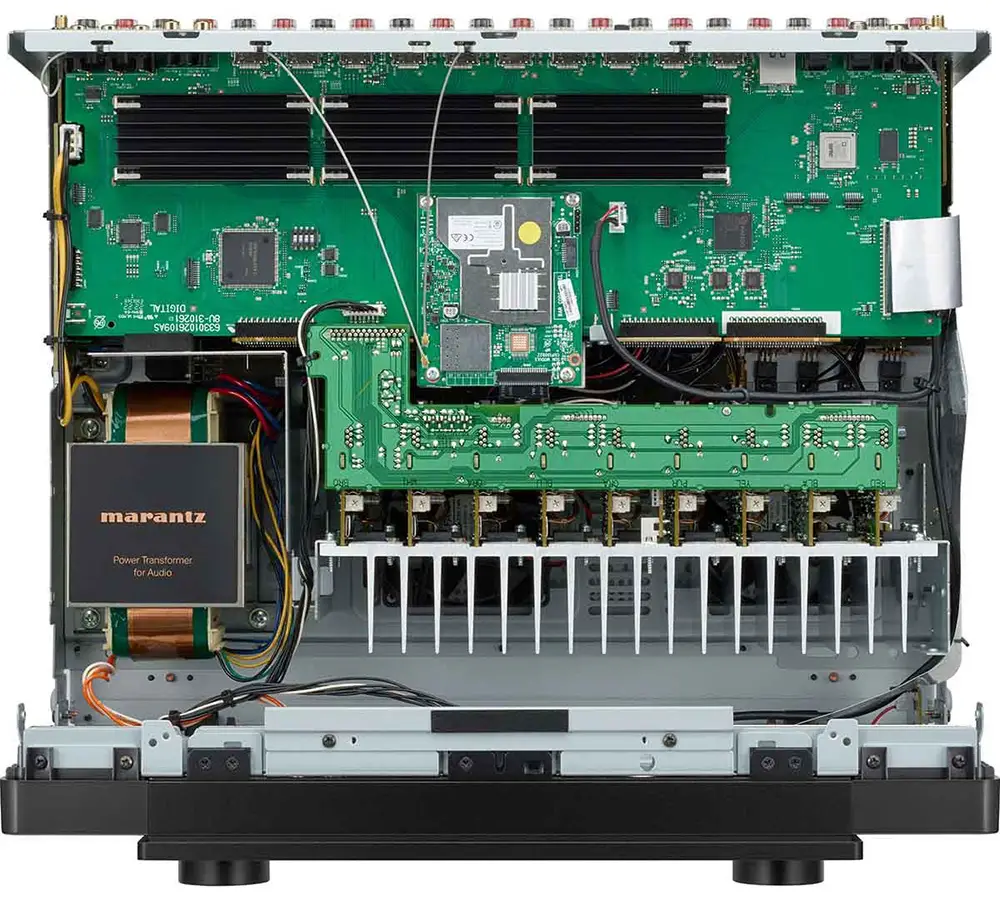
But the number of improvements on the Cinema 40 go beyond the above. The unit uses an oversized power transformer with copper band shielding in order to limit radiation and as a result distortion. Also specially Made for Audio capacitors are used which is typical in these premium AV receivers.
The Cinema 40 also comes with a Clock Jitter Reducer. If there is jitter in the clock that serves as the reference for D/A conversion, the reproduced waveform will be blurred and an accurate sound cannot be produced. The Clock Jitter Reducer compares the phase of the input and output signals to reduce jitter.
Since Marantz decided to update the looks of their units the remote had to follow too. As such the one we have now is not fundamentally different from the usual Denon/Marantz remotes but at least its looks feel more fresh and in line with the new units. And the one supplied with the Cinema 40 is the same one we saw in the rest of the series.
The top of the remote is where all of the inputs are located while volume, channels and navigation controls are placed in the middle, as we usually see, followed by three playback buttons with four selection buttons underneath them. At the bottom we get the four sound modes to choose from.
But the remote is not only just refreshed looks as it actually got a backlight function also. While this is not motion sensing, the button that activates it is located at the side instead of the top face among the rest of the buttons. This is the next big thing as it is far easier to press a single button at the side of the remote instead of trying to find it among all others. We never understood the usefulness of a backlight button mixed with all the other controls.

The Cinema 40 is really an engineering marvel. The number of changes and improvements it went through compared to its predecessor clearly shows that Marantz took the time and effort to offer us something really unique.
Audio Quality
Another area where the Cinema 40 gets the same kind of update treatment as the Denon X4800H is in the audio formats support. The receiver can playback the usual Dolby Atmos and DTS:X object oriented audio tracks but along with these we get support for up-mixing and virtual technology features in order to cover all needs and specific room configurations.
When it comes to up-mixing tech we find the usual Dolby Surround and DTS Neural:X. What these up-mixing modes are doing is to up-convert stereo and legacy mixes in order to make use of all the speakers you have in your setup. As for virtual modes the Dolby Atmos Height Virtualization and DTS Virtual:X are capable of creating sounds that originate from virtual created speakers around your room where there are no physical speakers present.
This virtual tech obviously is not as good and accurate as having real physical speakers and are very much room dependent. Also the sound many times can be heard very over-processed something we were never very fond of.
We also get IMAX Enhanced and Auro-3D support, which the SR7015 also had, but these are not all as we get some tasty new entries that are included in many of Sound United new models. One of them is Sony’s 360 Reality Audio which the receiver can support by connecting a 360RA streaming device via HDMI.
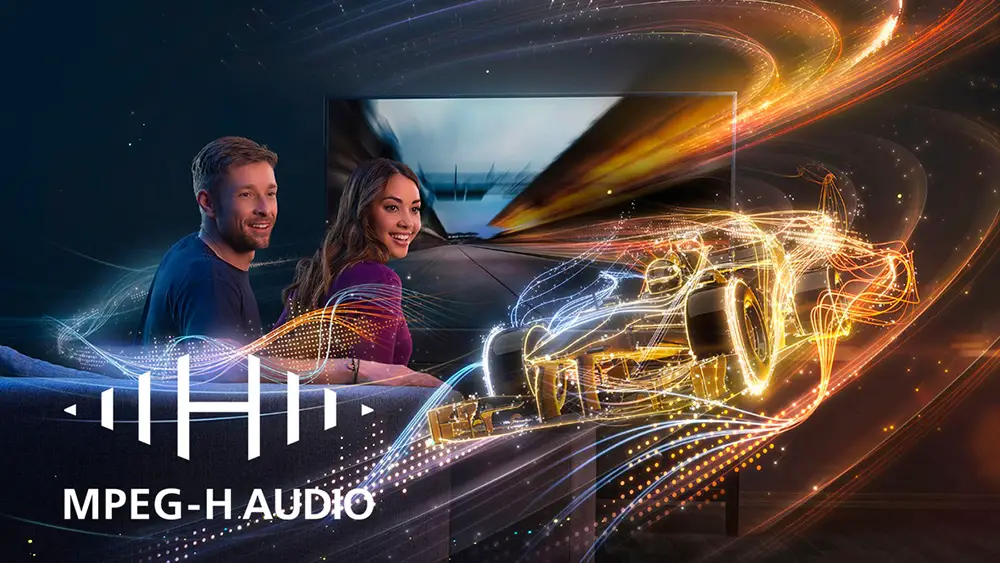
And lastly there is support for MPEG-H codec which has started to be used extensively for broadcasting. It is already being used with ATSC 3.0 in South Korea and over DVB in certain European countries while it is being used in several streaming services like Amazon Music and Tidal for powering their 360 Reality Audio music. It seems that we will be hearing MPEG-H more often lately as it seems to gain some notable traction.
The Cinema 40 comes with 9 channels of built-in amplification with each channel being able to output 125 watts of power (8 ohm, 20 Hz – 20 kHz, 0.05% 2ch drive) which in theory is very similar to the SR7015. Keep in mind that this is only for 2 channels driven meaning that when all 9 channels are active this number goes down considerably. You also have the ability to go all the way to 11 channels but for that you will need an external amp to drive the last two channels.
A major change this year is the addition of four subwoofers from two that was available in the SR7015. Multi-subwoofer setups are very common among home theater fans and it seems that Sound United took notice of this. As such the inclusion of four outputs allows for immense control over the kind of setup you want to create.
If you indeed go with four subwoofers the AV receiver allows you to handle them in two different ways. Either in standard or directional mode and the difference is that in standard mode all of them will output the exact same signal while in directional mode each subwoofer will output a signal depending its position and relation to the rest of the speakers.
With the built-in amplifiers you can go all the way for a 5.4.4 channels audio setup with four dedicated overhead speakers for maximum immersion. For the purpose of this review we went for a 5.1.4 setup using a single subwoofer and 4 height speakers placed at the front and back of our viewing area.
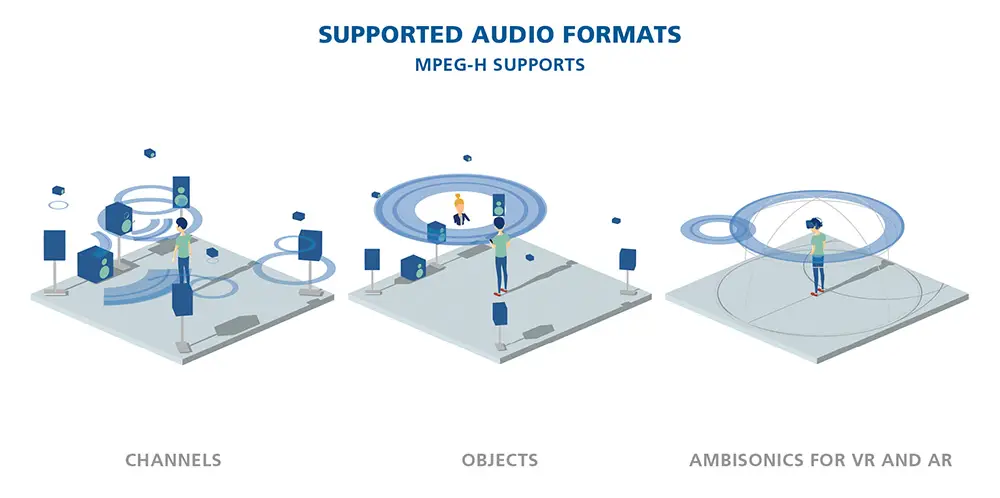
We started our movies testing with Godzilla vs Kong and Mad Max: Fury Road and finished with the obvious choice of Lord of the Rings: The Return of the King, all of them in their glorious 4K UHD editions featuring absolutely breathtaking Dolby Atmos mixes.
What can be said about such a monster of an AV receiver? You can write thousands of words and still not be able to fully show what this wonder box is capable of. Because from the moment you connect and calibrate it be ready for a rollercoaster ride like no other. The Cinema 40 knows how to handle the source material and we saw this in all sequences we tried out in our tests.
It didn’t matter what the scene was about. Either it was Godzilla solving his differences with Kong aboard an aircraft carrier, a car chase in the middle of the desert heading straight into a thunderstorm or the ride of the Rohirim on Pelennor fields, the Cinema 40 always rendered everything with such clarity, precision and pinpoint accuracy that almost made us feel like we were actually there.
The front soundstage was bold, powerful and vastly expansive pushing the sound towards the sides and providing the kind of depth that extended much further than where our test TV was. Everything was in harmony and all dialog was nicely separated from the two main channels keeping all voices crystal clear and distinct.
Equally impressive was its surround performance. Nice directionality with pinpoint precision and fast overlapping between the different speakers gave a sense of being right into the middle of the action. There was no audible delay with panning effects and every source being heard from where it should.

On the same level of excellence were the Atmos effects. With four height speakers we had good separation between the front and the back and each sound would travel across the top layer realistically and naturally. As always Atmos effects are far more subtle than surround ones but do give the necessary extension on the overhead layer that can up the immersion even more.
And lastly the bass. Obviously as with the rest of the channels the kind of speakers you use is of utmost importance to the kind of performance you will get out of this AV receiver, and the same applies for the subwoofer. From what we heard the receiver proved to be an excellent handler and provided our subwoofer with all the low end information to give us plenty of shakes and good powerful bass that never felt muffled or boomy.
And before we close this part of our review we should mention about the AV receiver’s maximum output. With 125 watts (even if this is rated only for 2 channels) this model has plenty of juice for most home theater setups. Yes, surely if you have a very large dedicated home theater room separate amplifiers may behave better but for a single box solution this will do you great even if you are a power hungry user.
Overall the receiver did amazingly here. The kind of sound you will get out of it is surely well worth its money and at least in our humble opinion it was one of the best performances a single box solution can offer in terms of cinematic excellence.
Marantz AV receivers were always famous for their musicality and the new lineup makes sure to carry on that fame. As such this receiver supports not only the usual lower quality audio formats like MP3, WMA (up to 192 kbps) and AAC but can also playback High Resolution Audio in the likes of FLAC, ALAC and WAV files up to 192 kHz / 24-bit quality. DSD streaming is also available for both 2.8 and 5.6MHz.
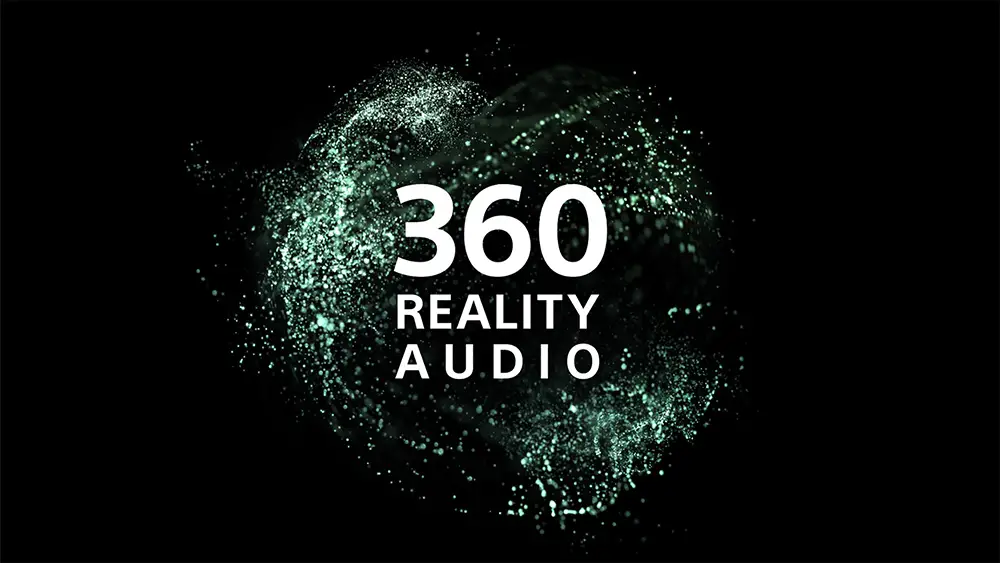
For this testing, as we usually do, we selected a few favorite tracks in FLAC format that we streamed through the front USB port for the best quality possible. Usually most people that go for the Marantz brand, do so due to their distinct music qualities and certain traits in their audio output that really favors music. And the Marantz Cinema 40, as was the case with the rest of the Cinema series, didn’t deviate from this path.
As we always tend to repeat when we review AV receivers, these cannot really compete with some top quality separate amplifiers. But AV receivers are not meant to go head to head in such a comparison. Their goal is to offer comparable performance all in a single box as practicality takes first place over having the utmost best performance.
But the Cinema 40 is not a simple compromise of space versus performance as its output can really challenge the quality of many separate setups and then some. Surely some top quality ones can still do better but the point is that to get them you will have to pay tremendous amounts of money in comparison to the cost of the Cinema 40. And when used in Direct more the receiver can give you the kind f musical fidelity that you will never doubt this purchase.
Its output had a very natural and smooth tone to it that is very characteristic of Marantz. The receiver is not the kind that push on the extremes, if this is your liking, but goes for a more balanced and pleasant rhythm that, at least to our ears, we could keep listening for hours upon hours.
Not that the unit cannot go wild if the source material asks for it, but in general it tries to go for a smoother output in comparison to Denon for example. Now if you like this or not is a different matter but surely there are many that prefer this tonality and audio signature compared to competing brands.
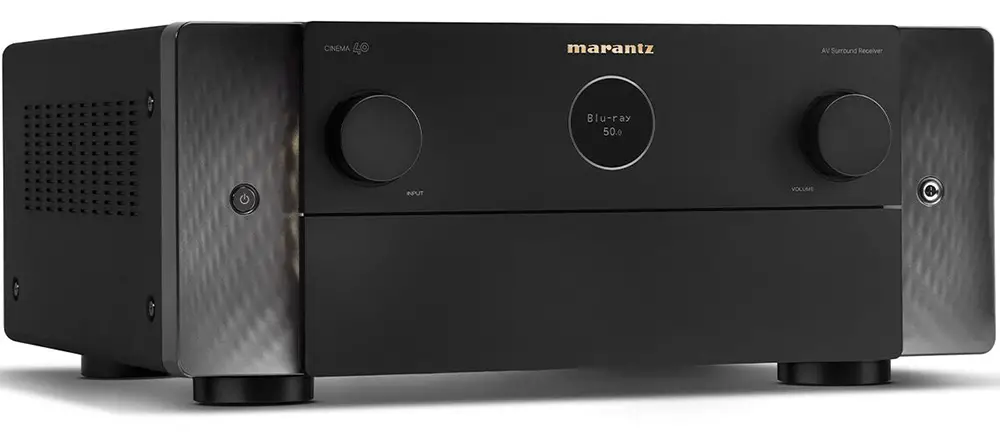
Going over various types of music and genres like Jazz, heavy metal, classical and finishing with some electronic music we can say that the Cinema 40 is dead serious about your music enjoyment as it is for your cinematic immersion. It handles everything with care, every little detail, every minor instrument and every single sound source in order to portray it in space the way it should. We never heard anything that felt out of place or any inconsistency in general.
In the end the Cinema 40 is like a real master that cements Marantz’s expertise in creating amazing AV receivers that can do great no matter what you throw at it. Nothing more, nothing less.
Ports and Connectivity
Let’s take a look at the connectivity capabilities of the Cinema 40 next and here we see that the new model comes with certain changes compared to the SR7015. On the contrary it looks awfully the same to the AVR-X4800H with only one minor addition that we are going to point out.
First of all we already mentioned above about the frontal ports that include the Headphones jack, the setup microphone port and the USB port. The front HDMI input is missing from this one too and we will continue to hope that at some point Sound United will decide to bring it back.
At the lower back we get the usual 11 speaker terminals that are placed in a straight line which helps a lot with cable management. The terminals are the usual quality we have seen from Marantz while they differentiate themselves with the use of transparent caps instead of Denon’s black and red ones. But, as usual, if you want to use the full 11 channels you will need an external amplifier for the last two channels.
At the top we find all the HDMI ports and what is impressive is the fact that all seven of them are of the HDMI 2.1 kind. There are also three HDMI outputs which is surely more than what most people will ever need. But more on these shortly.
As for all other connections we get 1 Ethernet port, 2 coaxial and 2 optical digital audio inputs, 11.4 channels pre-outs, 5 analogue audio inputs and one more dedicated for phono, a remote control input and one more output, an IR flasher input, an RS-232C port for control, three 12 volts trigger outputs and the usual FM/AM antenna inputs along with the WiFi/Bluetooth connectors.
Compared to the Denon AVR-X4800H the only real difference is that the Marantz also has a IR flasher input. Everything else is like for like and even the layout of both AV receivers match. Now compared to the SR7015, that is supposed to replace, the Cinema 40 completely loses the 7.1 multichannel inputs, comes with less composite and component connectors and loses one HDMI input.
On the other hand the Cinema 40 comes only with HDMI 2.1 ports, adds one more 12 volts trigger and comes with four subwoofer inputs instead of two.
Here we need to mention that the 4th subwoofer output can also be used to connect a tactile transducer or “butt shaker” that is very common among dedicated home theater fans. Now you don’t need to rely on 3rd party solutions as the Marantz has support for this built-in.
As for its HDMI ports the Cinema 40 comes with seven updated HDMI 2.1 ports that support all the old and new exciting technologies including 8K/60Hz and 4K/120Hz video passthrough with 40Gbps bandwidth, Deep Color, x.v. Color, HDR10, HDR10+, Dolby Vision, Hybrid Log-Gamma (HLG), Dynamic HDR, 3D, Quick Media Switching (QMS), Variable Refresh Rate (VRR), Auto Low Latency Mode (ALLM), Quick Frame Transport (QFT), Fixed Rate Link (FRL), ARC, eARC, Auto Lip Sync and HDMI-CEC.
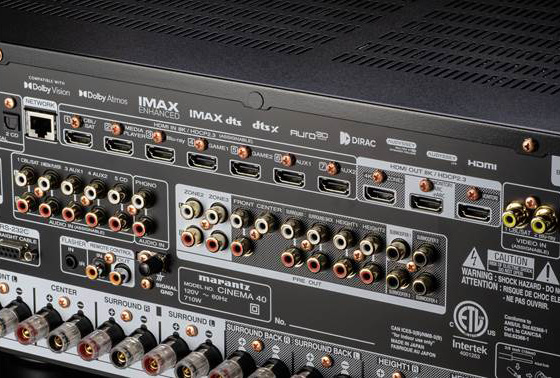
All the 2020 AV receivers that featured HDMI 2.1 ports came with a bugged Panasonic chip that wouldn’t allow it to pass certain signals, like 4K/120Hz RGB signals from the Xbox series X for example, as it would result in a black screen.
The Cinema 40 on the other hand seems to be using updated HDMI 2.1 hardware which allows up to 40Gbps of bandwidth on all of its HDMI ports and this includes all the signals with a 4K@120Hz configuration including Xbox Series X.
Here we need to mention that 40Gbps is not the full bandwidth the HDMI 2.1 protocol can support, with 48Gbps being the limit. 40Gbps is enough for 4K@120Hz signals with 10 bit color depth and 4:4:4 chroma sub-sample which includes the majority of the signals in today’s applications. But there are some gaming GPUs that can do 4K at 144Hz or higher and with TVs slowly supporting frame rates higher than 120Hz the 48Gbps limit will become more and more relevant. But there is no AV receiver with 48Gbps capable HDMI ports yet.
For the purpose of this review we tested both a PS5 and our Xbox Series X and we didn’t notice any problems in both cases as we we were able to get a 4K@120Hz signal with VRR engaged. The signal was stable during the time of testing with no HDMI handshaking problems or instability.
As for the unit’s wireless capabilities we get built-in WiFi which can connect both in 2.4GHz and 5 GHz networks as well as Bluetooth connectivity. From the looks of it the Cinema 40 has been upgraded in both fronts as it now supports up to IEEE 802.11a/b/g/n/ac while its Bluetooth module is now v5.0 from the previous v4.2.
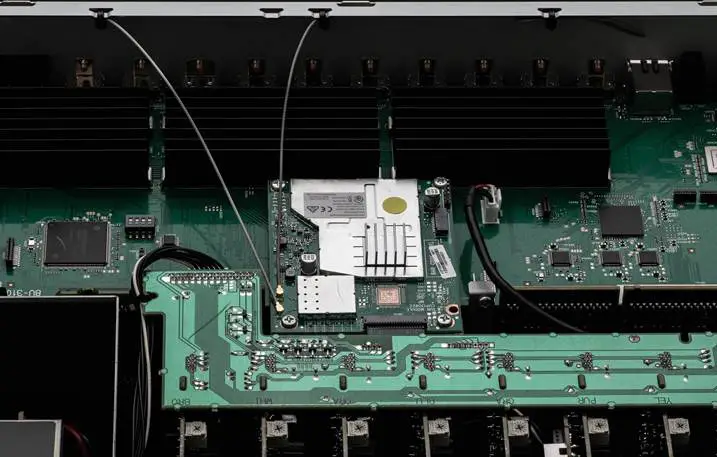
The Cinema 40 changed things a bit when it comes to its connectivity options. It is obvious that analog ports are being slowly reduced but the most important change is the inclusion of seven, 40Gbps HDMI ports. If only we had a front HDMI input also and we would be more than happy…
OS, Apps and Features
Next we will mention all the extra features that the Cinema 40 includes and surely this is a pretty extensive list, even if not all that different from what the Cinema 50 came with. As such this part of our review will be similar, but as always we will make any necessary changes wherever needed.
Let’s start with the audio correction system and this time we have two of them. Marantz is once again using the Audyssey system, as usual, and as with all manufacturers they scale it accordingly to meet the price and performance standards of each of their models. For the Cinema 40 we get the Audyssey MultEQ XT32 version which is their best and most feature complete suite. In comparison this one features the highest resolution filters, compared to the other versions, which can result in higher accuracy during calibration.
The Audyssey MultEQ XT32 also comes with Dynamic Volume, Dynamic EQ, Audyssey LFC and Audyssey sub EQ HT. This version of Audyssey has the ability to analyze up to 8 different listening positions with the help of the included microphone and creates precise digital filters in order to offer the best audio result for your particular space.
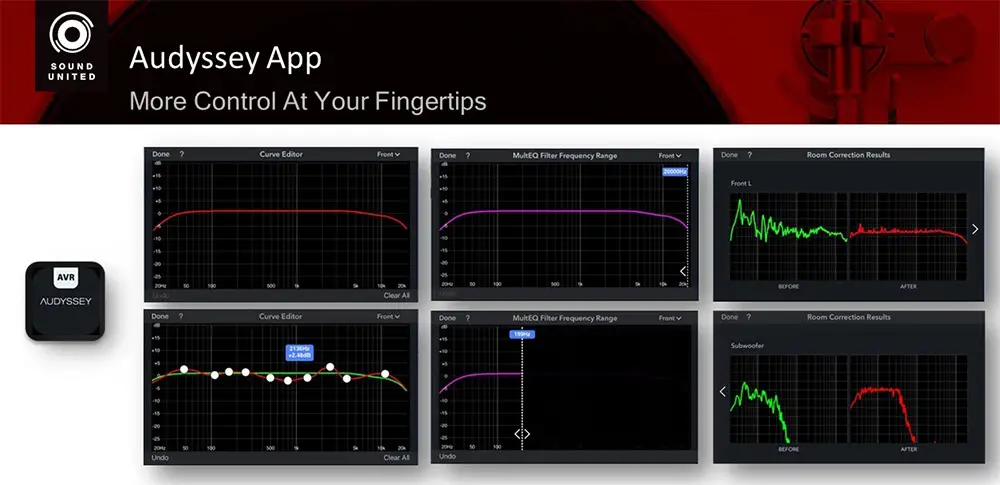
But except from the core system we also get Dynamic EQ which is a feature that is responsible for keeping the clarity and dynamic levels of audio even when you like to watch at low volume, like for night viewings for example. Dynamic Volume on the other hand is capable of balancing sudden changes and spikes in volume that could appear when there are sudden changes from TV broadcasting to commercials.
There is also Audyssey LFC that uses advanced psychoacoustic algorithms to deliver more full-range balance, including deep bass, without disturbing neighbors or people in other rooms of your home and lastly Audyssey Sub EQ HT that provides individual DSP tailoring of each subwoofer in a multi subwoofer setup for deeper bass with improved definition.
Another feature that makes a come back from previous releases is sound presets. The Cinema 40 has the ability to store two Audyssey settings and switch between the two settings on the fly, giving you the freedom to tweak your listening experience based on content or listening environment. This can be especially handy if you like to watch different types of films and want to have a setup created specifically for each type.
Going through the Audyssey calibration can be done either through the built-in wizard or if you want to dive deeper into calibrating your system then you can download the Audyssey MultEQ Editor app that is available for Android or iOS and do a more thorough setup with the help of your mobile device.
Only keep in mind that this app has a one time fee which is a shame to be honest when you already pay such an extremely high price for this unit. As for the built-in system, this is more than enough for most casual users as it offers almost everything you need to make very good and precise adjustments to your system.

The big news for the new Cinema series is obviously the inclusion of Dirac Live and the Cinema 40, as was the case with the Cinema 50, is Dirac Live ready. Dirac Live is an audio calibration system that is included in the new unit and is about to become available just as Marantz promised for a March 2023 debut. This means you will be able to choose either the free Audyssey system that will work out of the box for every unit or buy a Dirac Live license for more advanced tuning.
The Dirac Live availability will be completed in two steps. The first one, as we mentioned, will start momentarily in March 2023 with the availability of the room correction feature in two packages, the limited or full bandwidth, while the second phase will come sometime in 2024 with additional bass control management for a single subwoofer or multiple ones. Sound United has announced the prices for all packages and according to them these are dictated by Dirac themselves.
Dirac Live was a hugely requested feature and it seems that the time has finally come which surely gives a major advantage to the Cinema 40 in its category.
Now, in case you don’t like to control the AV receiver with the remote there is always the option to use the available mobile app. The Marantz AVR Remote app, as it is called, lets you control the unit with your mobile device through a nice visual interface. The app is available for both Android and iOS devices and you can get it from their respective online stores.
Another change we find this year is the new refreshed UI. For some years now we were complaining about how old style and outdated the UI of the Marantz AV receivers looked. It was as though it belonged in the early 2000s with its outdated menus and 480p resolution.
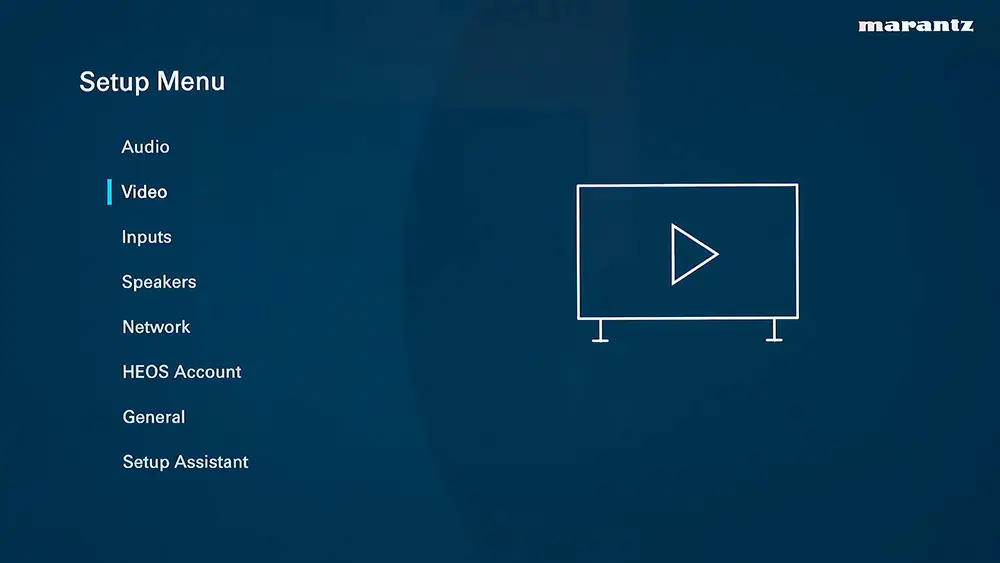
It seems that Marantz, or rather Sound United, finally listened to our cries and decided to update it in both their Marantz and Denon units. The menus are not all that different in terms of structure and layout. You still get the same list of features in a similar way to the old UI but they bumped the resolution up to 1080p and made it look graphically more pleasing to the eye. Now it feels like it is something newer and although it may not be as fancy as what smart TVs have, it is far better that what we were getting till now.
But there are much more that we need to talk about when it comes to what features the AV receiver comes with. The Cinema 40 comes with the usual streaming as well as multi-zone capabilities that Marantz includes in almost all their units. As it supports both HEOS and Airplay 2 you can either stream music online from one of the available online streaming services that include Spotify Connect, Pandora, Amazon Music HD, TuneIn, Deezer, SiriusXM and TIDAL among others or create your own multi-room environment with the use of appropriate wireless speakers.
Both the HEOS and Airplay 2 apps are available for downloading from their appropriate stores for use with your mobile device. But if you prefer a wired connection the Cinema 40 also supports Zone 2 and Zone 3 through its dedicated pre-outs or one of the HDMI outputs available at the back of the unit.
Now as far as streaming, online is not the only option you have as you can stream audio from a network drive or NAS server if it happens you to have one connected to your local network. Also with the included USB port you can stream music through some connected external storage or flash drive.
Lastly if you prefer a more wireless way of streaming your music there is Bluetooth available for connecting with your mobile device. If you use Apple devices then Airplay 2 can also be used to stream music wireless through it.

And since we mentioned Bluetooth another function that is included in the Cinema 40 and seems to be a standard nowadays is that the receiver can output audio in two different ways using its Bluetooth transmitter. The AV receiver is capable of streaming audio to Bluetooth enabled headphones for a completely silent house experience or it can also output sound from both its speaker terminals and to a Bluetooth headset. This can be very practical in case there is a member in the family that is hearing impaired.
But keep in mind that this can be used only for music and not for movies. And this happens because the Bluetooth transmitter of the AV receiver is using only the SBC codec and not some more advanced variant meant for such use, like aptX Low Latency. As a result there is bound to be an audio delay due to the Bluetooth transmission speed making this feature ideal only for music use.
We already mentioned above that the receiver supports USB streaming but we should also note that the unit comes with M-DAX2 support. Compressed music enhancement in the Cinema 40 is done by Marantz MDAX2 technology. The use of compressed audio files like MP3, Windows Media Audio or AAC is more popular than ever.
The audio quality of these compressed files however is less than what is found in the original lossless files that are on a CD, especially lacking in the higher frequencies and affecting the lower frequencies which make the audio image less wide and deep. The Marantz Digital Audio Expander 2, also called M-DAX2, recalculates the outputted frequency range. This enables you to get a more detailed and clearer sound.
Having tried this feature before we can say that it may not be the magical feature that will turn low quality MP3 files into high resolution audio but surely in certain cases the difference can be notable. So we do advise you to try it out as it can be handy depending the source material.

Voice control is another standard feature so it couldn’t be missing from the Cinema 50 either. As such the unit supports all the major ones including Amazon Alexa, Google Voice Assistant and Apple HomePod. Obviously for all of them you will need the appropriate external device to issue your commands.
Marantz was always offering strong custom installation capabilities to their AV receivers and the Cinema 40 continues this trend. The unit features external RS232, IP control capabilities and an IR flasher input for easy customization and compatibility with third-party integration solutions.
IR (infrared) remote control input and output are also included on the rear panel for remote control compatibility with other components in your home theatre system. From all the above it is very obvious why the Cinema 40 is a heaven for custom integrators.
Another handy feature that we do find is HDMI-CEC and this one lets you use the TV remote to control the AV receiver if the TV also supports this. You can understand the practicality of this as this way you can reduce the amount of remotes you will need to have in your home theater. Obviously this feature lets you use only the most basic functions of the receiver but for everyday use it can be a very time saving one.
But we are not finished yet as there are even more features that need to be mentioned. The Cinema 40 can pass-through video signals from both its HDMI and analog ports to its HDMI outputs but when it comes to upscaling there are certain limitations as analog signals cannot be up-scaled while through HDMI only certain resolutions can be upscaled to 4K or even 8K. The manual includes a detailed table of all the conversions possible.

We also get an ECO mode that can regulate the receiver’s power usage for a more environmental friendly power consumption but if you want the AV receiver to work on its full strength you better leave this off.
Another famous feature is “Roon Tested” certification. For this last one there seems to be a bit of confusion as there are two types of certifications. Roon Ready and Roon Tested. The Cinema 40, as with all Marantz AV receivers, is Roon Tested which means that while Roon will work on this unit you will not get the highest quality possible.
So for example if you use Airplay, audio quality is limited to 16 Bit/44.1kHz. Keep that in mind in case Roon is specifically important to you but you also want your files to be streamed in their original, highest quality possible.
Lastly we get an upgrade to a previous included feature and this is the Pre-Amplifier mode which is now called Advanced Pre-Amplifier mode. With it your Marantz AV receiver works as a perfect AV pre-processor with the latest HDMI connectivity.
Pre-Amplifier Mode provides a cleaner signal path and more tolerance in clipping level by disconnecting internal amplifiers. The difference this year with the Advanced version is that you can choose how many channels you want to disconnect from the main unit and as a result you can add various external amplifiers in the future according to your needs.
As you understand the feature list is extremely extensive but we managed to mention almost all the major ones. With so much available the Cinema 40 is an AV receiver that surely can handle any situation and any setup no matter how demanding you may be or how complex the setup you want to make is.
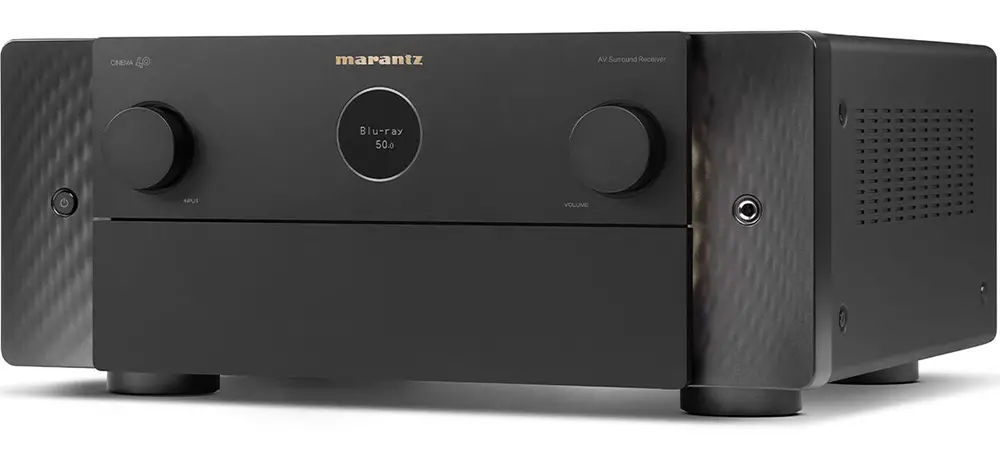
Final Thoughts
Many people rightfully wonder why to pay so much money when the Denon AVR-X4800H offers similar specs and an awfully similar feature set for almost $1,000 less. Well the answer is not easy if you do not hear both of these units in order to understand the small differences they have. What we can say is that their audio signatures are different even if these differences are small and very subtle. Now if this can justify the cost is something that each person may have a different opinion about. But for us it definitely deserves it.
There are so many good things to say about the Cinema 40 that is impossible to include them all in a single paragraph. Its cinematic capabilities are undeniable, its musicality and warm audio signature is obviously a Marantz highlight while its specs puts this one at the top of its game. With the inclusion of 40Gbps HDMI inputs, a plethora of connectivity options and a massive feature list, the capabilities of this unit are almost unlimited.
With such an impressive unit did we find anything that we didn’t like? The analog ports have been reduced, which we do not necessarily see as bad, but the omission of the front HDMI input is a major one in our books. The Audyssey MultEQ Editor app should be offered for free, the 40Gbps HDMI 2.1 ports may suffice for now but they surely will not when higher bandwidth signals become more popular and lastly the price is far higher than previous releases.
We reached the end of our review and we cannot but feel extremely satisfied with what we saw in this one. The Marantz Cinema 40 is an AV receiver that left us in awe no matter the source material and surely is one of the best choices you can make for your home theater, no question about it. Highly recommended.

For more reviews you can check our dedicated 9 channels 8K AV Receiver reviews list or even look at our Product Reviews Table where you can find the brand and specific product you are looking for.
Cheapest Places to Buy :
*We are a reader-supported website. When you buy through links on our site, we may earn a small affiliate commission at no extra cost to you. Home Media Entertainment does not accept money for reviews.*
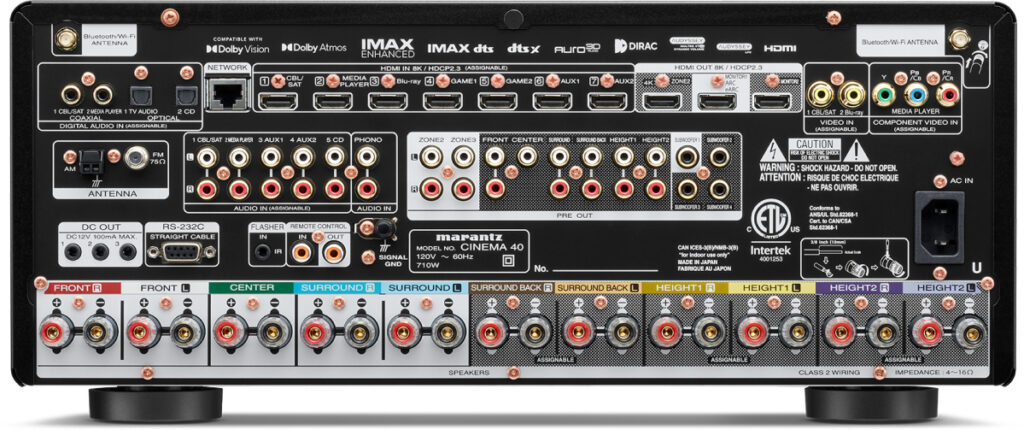
I always loved Marantz and their models but the price of the Cinema 40 is crazy. They surely have gone up in recent years. As much as I love the brand I don’t know if I would justify to give $1,000 more when the Denon offers exactly the same features, even if their sound is indeed slightly different.
Hello Joseph, indeed prices have gone up across the board and this is a sad reality in this field. As for the price difference with Denon, well. I have heard arguments both ways and surely there is no right or wrong decision here. Some people think it is worth it, some don’t. That’s why we try to present all facts in our reviews so you can decide for yourself.
Thanks for your helpful insights and careful review! I am still trying to find out, if an upgrade to the new cinema 40 is worth it to me (SR7015, 7.1.2 speaker). Especially, since I got for all minor drawbacks of the 7015 working work-arounds so far (integration of hue sync, PS5 VRR and so on)… The grass is always greener on the other side and you confirmed everything I would expect from a receiver in this price range.
Hey Markus. I know the feeling when a new model comes out and you are toying with the idea of an upgrade. But one thing I have learnt all my years in this field is that if something works as you want it to and it has everything you need then you don’t change it! And since you already have an SR7015 and you managed to make it work the way you want my advice to you would be to keep it.
Amazing AV receiver but damn expensive. The prices have really gone up lately it’s becoming ridiculous. I always loved Marantz but with such cost I prefer to go for the SR7015 instead as the prices for those have gone considerably down. And for me this is enough as there is nothing on the Cinema 40 that I would use that the 7015 doesn’t have.
Hello Amyas. Indeed the prices have gone up considerably and this is a fact across all electronics. But if you can go by with the SR7015 then surely you can save a lot of money.